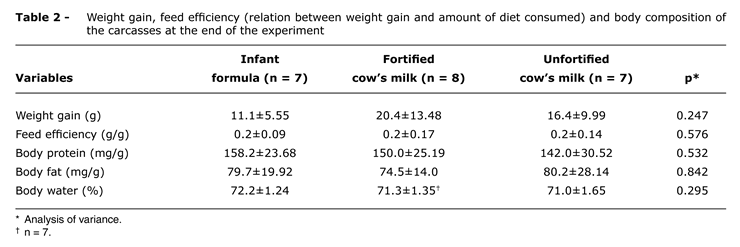OBJECTIVE: To compare iron absorption from infant formula and iron-fortified cow's milk. METHODS: Twenty-four weanling Wistar rats were maintained in metabolic cages during the whole experiment (10 days). On the first day, the animals were divided into three similar groups according to their weight, length, hematocrit and hemoglobin levels: 1) infant formula; 2) powdered whole cow's milk fortified with iron in the same quantity and type as the formula; 3) control - powdered whole cow's milk not fortified with iron. Deionized water and diet were offered ad libitum, and the volume consumed was measured. Weight, hematocrit, and hemoglobin levels were measured on the fifth and 10th days when length, fecal occult blood, and hepatic iron levels were also analyzed. RESULTS: Group 1 consumed less diet (450.5±26.50 mL) than group 2 (658.8±53.73 mL) and control group (532.7±19.06 mL, p < 0.001). Hemoglobin levels were higher (p < 0.001) in group 1 (12.1±1.13 g/dL) than in group 2 (9.6±1.59 g/dL) and in control group (6.2±0.97 g/dL). Hepatic iron level showed the same pattern as hemoglobin (p < 0.001). There was no difference in weight and length between the three groups (p = 0.342). There was no fecal occult blood in the any of the animals. CONCLUSIONS: Despite the lower volume consumed, the group that received formula presented higher iron absorption and hemoglobin levels than the group fed with fortified whole cow's milk. Growth was similar in the three groups.
Breast milk substitutes; dietary iron; biological availability; iron deficiency




